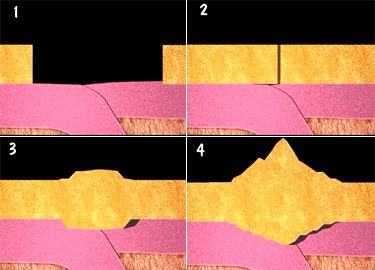
Convergent Plates - another type of convergent plate occurs when two continents collide with one another. This type of collision produce a subduction zone, but it is so deep and contains little or no encapsulated water so it rarely produces magma and volcanoes.
At the leading edge of the collision the continental crust must expand in two directions to encompass the volume of rock being pressed together. This forms great mountain ranges with the formation of much additional crust below them.
Remember the Principle of Isostasy, in order to support a high mountain range there must be a equal support structure below.

Transform margins - the third type of junction is a transform junction, and here plates move laterally by each other.
In this example assume that the two color spheres are landmarks or cities on opposite sides of two adjacent plates. As the plates move, the two landmarks move apart. Lateral motion is not smooth and is often not at constant speed. Energy may build up in the junction and then movement frees up the pent-up energy in a quick release ... an earthquake.
The St. Andreas fault in California is an excellent example. This fault is actually a plate margin where Los Angeles on the outer plate is moving toward San Francisco on the inner plate at the rate of about 12 cm per year.
| NEXT | TOC | PREV |